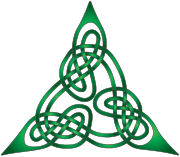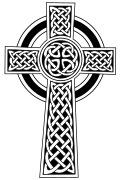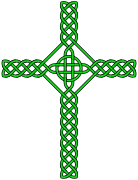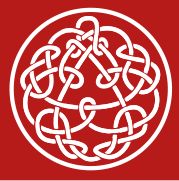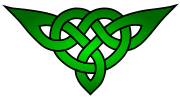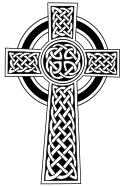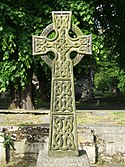Keltisk knude

En keltisk knude (irsk: snaidhm Cheilteach, walisisk: cwlwm Celtaidd, kornisk: kolm Keltek, skotsk gælisk: snaidhm Ceilteach) er en type af knude og stiliseret grafisk repræsentation af knuder der bruges til dekoration, og i særdeleshed i keltisk insulær kunst. Disse knuder kendes især for deres brug i ornamenter på kristne monumenter og manuskripter, som Lichfieldevangelierne, Book of Kells Lindisfarneevangelierne. De fleste er uendelige knuder og mange er variationer af kurvefletknuder.
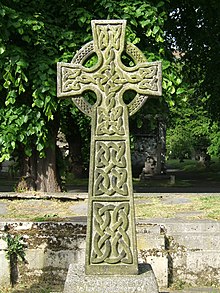
Sammenflettede mønstre kendes tilbage fra slutningen af Romerriget.[1] Knudemønstre optræder i tredje og fjerde århundrede e.v.t. og kan ses på romerske gulvmosaikker. Udvikling af knudemønstre ses i byzantinsk arkitektur, illuminerede manuskripter, koptisk kunst, keltisk kunst, islamisk kunst, bogilluminationer fra Kijevriget, ethiopisk kunst og europæisk arkitektur og bogilluminationer.
Keltiske knudedesigns blev populære i tatoveringer i USA i 1970'erne og 1980'erne.[2]
Eksempler
| Eksempler på keltiske knuder | ||||||||||||||||||||||
| ||||||||||||||||||||||
Se også
- Keltisk kunst
- Keltisk knapknude
- Keltisk kors
- Kroatisk fletværk
- Uendelig knude
- Islamisk fletmønster
- Khachkars
- Knudehave
- Knude (matematik)
- Osebergstil
- Trikvetra
Referencer
- ^ Trilling, James (2001). The Language of Ornament. World of Art. Thames and Hudson. ISBN 978-0500203439.
- ^ Shapiro, Ari (25. november 2014). "The American Origins Of The Not-So-Traditional Celtic Knot Tattoo". NPR. Arkiveret fra originalen 23. januar 2019.
Eksterne henvisninger
- Draw Your Own Celtic Knotwork Comprehensive list of links to both knotwork tutorials and a knotwork bibliography
- Celtic Interlace - An Overview Arkiveret 19. juni 2020 hos Wayback Machine by Stephen Walker, reproduced with permission from Dalriada Magazine, 2000
- Font with Zoomorphic (animal) ornaments GPL Font and generator project
- Celtic Knot Generator Online Celtic knot designer that uses the Knots typeface.
Medier brugt på denne side
A quasi-celtic cross made of large symmetrical knot with a circle interlaced through its center. The knot is made up of straight lines which are vertical, horizontal, or at 45° angles, and of circular arcs all of the same radius. If the large circle were to be removed, then the over-under interlacing of the crossings of the horizontal and vertical lines at the center would have to be reversed to preserve the alternation of the knot interlace pattern (see Celtic-knot-cross no circle.svg).
Celtic cross, created with Sodipodi vector software. Ornamental version of Celtic "high cross" with decorative knotwork by Petr Vodicka (original source http://www.sodipodi.com/clipart/decorative/ccross.svg http://www.sodipodi.com/clipart/decorative/ccross.txt ).
Triquetra knot, created with Sodipodi vector software
Slightly modified version of quasi-Celtic knot by Petr Vodicka, created with Sodipodi vector software. Equivalent to mathematical knot 1075.
A small part of the Roman mosaic (called the Great Pavement) at Woodchester, Gloucestershire, England.
The mosaic is 48 feet by 48 feet (15 metres by 15 metres) and uses 1.5 million pieces of stone, each 0.5 by 0.5 inches (12 mm by 12 mm ). Once the floor of a main hall of a Roman villa, it was laid around AD 325.
Photographed by Adrian Pingstone in 1972 (the last time the mosaic was on display).
One very basic form of Celtic or pseudo-Celtic linear knotwork. For alternative forms, see Celtic-knot-basic.svg, Celtic-knot-twoloops-bigends.svg , Bar-knot-basic-decorative.png, and Celtic-knot-basic-rectangular.png.
For variant forms of a basic (pseudo-)Celtic knotwork cross, see Knotwork-cross.svg , Knotwork-cross-multicolored.svg , and Knotwork-cross-alternate.svg .Forfatter/Opretter: Froaringus, Licens: CC BY-SA 4.0
Romanesque cross of the church of Santa Susana, Santiago de Compostela, Galicia.
(c) Andreas F. Borchert, CC BY-SA 4.0
Carved celtic knot at the doorway to the tower.
Forfatter/Opretter: 20040302, Licens: CC BY-SA 4.0
This is an example of machine generated Celtic knot work, using modern typographic features to depict traditional looking Celtic knots with zoomorphs (animal heads and tails).
Forfatter/Opretter: Tracy fra North Brookfield, Massachusetts, USA, Licens: CC BY 2.0
Celtic cross on a grave in Brompton Cemetery, London
A basic form of a Celtic knotwork cross (multicolored version). For a non-filled version, see Image:Knotwork-cross.svg , and for an alternate version see Image:Knotwork-cross-alternate.svg .
The blue part is a Bowen knot.
For variant forms of basic linear Celtic / Pseudo-Celtic knotwork, see Image:Celtic-knot-basic-alternate.svg , Image:Celtic-knot-basic.svg , Image:Celtic-knot-basic-linear.svg , Image:Celtic-knot-twoloops-bigends.svg , Image:Bar-knot-basic-decorative.png , and Image:Celtic-knot-basic-rectangular.png .A simple Celtic knot with doubled threads. The design is taken from an ornament in the Lindisfarne Gospels, fol. 211r, where it appears at the base of the P of principium in the opening phrase of the Gospel of John, IN Principium erat uerbum.
(c) Steve Ball, CC BY-SA 3.0
Steve Ball's "Possible Productions knotwork" appears on the cover of later versions of the King Crimson album Discipline. Ball's design has been used as the logo for Robert Fripp's music-company Possible Productions and his music-label Discipline Global Mobile (DGM). By policy, DGM does not own either copyrights or moral rights to its art; here, the design's copyrights belong to Steve Ball, who has granted a CC 3.0 SA BY license.



